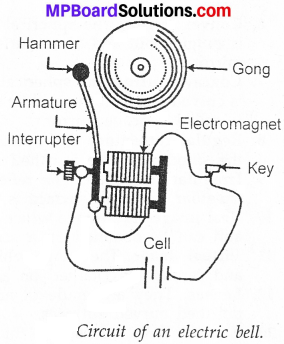MP Board Class 7th Science Solutions Chapter 14 Electric Current and its Effects
Electric Current and its Effects Intex Questions
Question 1.
Paheli and Boojho wonder whether the batteries used in tractors, trucks and inverters are also made from cells. Then why is it called a battery? Can you help them to find the answer to this question?
Answer:
The battery used in tractors, trucks and inverters is a combination of several cells. The cells are not dry cells. These are the several sets of plates and each set of plates acts like a cell.
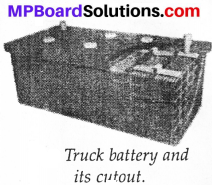
Question 2.
Paheli and Boojho saw a magic trick sometime back. The magician placed an iron box on a stand. He then called Boojho and asked him to lift the box. Boojho could easily lift the box. Now the magician made a show of moving his stick around the box while muttering some thing. He again asked Boojho to lift the box. This time Boojho could not even move it. The magician again muttered some thing and now Boojho could lift the box? The audience, including Paheli and Boojho, were very impressed with the show and felt that the magician had some supernatural powers. However, after reading this chapter Paheli is wondering if the trick was indeed some magic or some science was involved? Can you guess what science might be involved?
Answer:
The magician arranged an electromagnet below the box. The electromagnet could be turned ‘ON’ and ‘OFF’ as when the magician signals his assistance. When the electromagnet is turned ‘ON’ it attracts the iron box and hence it could not be lifted.
![]()
Electric Current and its Effects Text Book Exercises
Question 1.
Draw in your notebook the symbols to represent the following components of electrical circuits: connecting wires, switch in the ‘OFF’ position, bulb, cell, switch in the ‘ON’ position, and battery?
Answer:
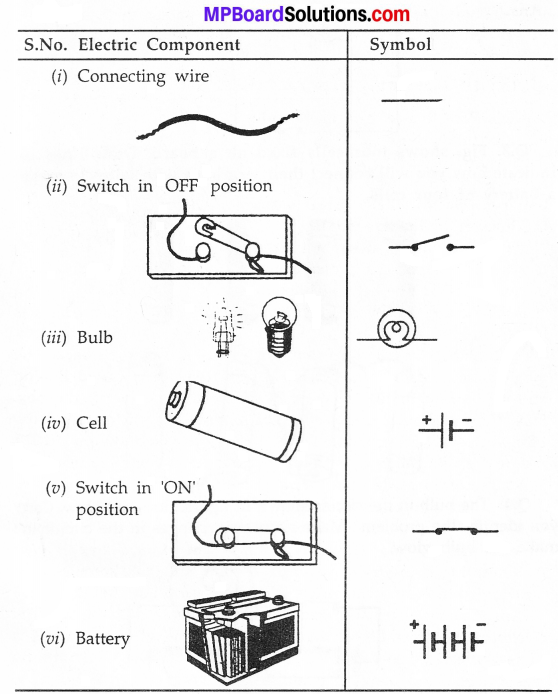
Question 2.
Draw the circuit diagram to represent the circuit shown in fig?
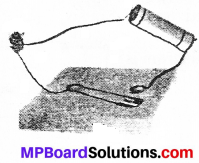
Answer:
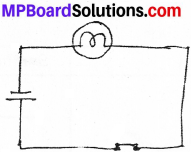
Question 3.
Fig. shows four cells fixed on a board. Draw lines to indicate how you will connect their terminals with wires to make a battery of four cells?
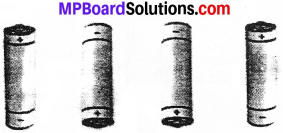
Answer:
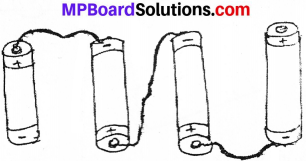
Question 4.
The bulb in the circuit shown in figure, does not glow. Can you identify the problem? Make necessary changes in the circuit to make the bulb glow?
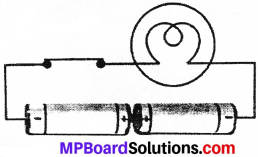
Answer:
The problem with the circuit is that both the negative terminals are connected to the bulb. The corrected diagram is shown below:
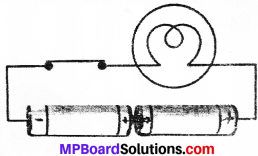
Question 5.
Name any two effects of electric current?
Answer:
The two effects of electric current are heating effect and magnetic effect.
Question 6.
When the current is switched on through a wire, a compass needle kept nearby gets deflected from its north-south position. Explain?
Answer:
When electric current passes through a wire, it behaves like a magnet. This is the magnetic effect of the electric current due to attraction of the wire. So, the compass needle which is a magnet, gets deflected.
Question 7.
Will the compass needle show deflection when the switch in the circuit shown by fig is closed?
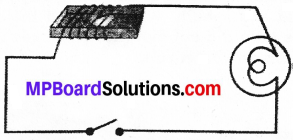
Answer:
No, because there is no cell so no current will flow.
Question 8.
Fill in the blanks:
- Longer line in the symbol for a cell represents its ………………………… terminal.
- The combination of two or more cells is called a …………………………..
- When current is switched ‘on’ in a room heater, it ………………………..
- The safety device based on the heating effect of electric current is called a ………………………
Answer:
- Positive
- Battery
- Get heated
- Fuse.
Question 9.
Mark T if the statement is true and F if it is false:
- To make a battery of two cells, the negative terminal of one cell is connected to the negative terminal of the other cell.
- When the electric current through the fuse exceeds a certain limit, the fuse wire melts and breaks.
- An electromagnet does not attract a piece of iron.
- An electric bell has an electromagnet.
Answer:
- False
- True
- False
- True
![]()
Question 10.
Do you think an electromagnet can be used for separating plastic bags from a garbage heap? Explain?
Answer:
No, the plastic bags do not get attracted by the magnet, so they cannot be separated by an electromagnet. The plastic bags are not magnetic materials, only magnetic materials like iron can be attracted by magnet.
Question 11.
An electrician is carrying out some repairs in your house. He wants to replace a fuse by a piece of wire. Would you agree? Give reasons for your response?
Answer:
No, because this piece of wire will not melt even if high current flows through it. So, it will not prevent the damage done by high current.
Question 12.
Zubeda made an electric circuit using a cell holder shown in figure a switch and a bulb. When she put the switch in the ‘ON’ position, the bulb did not glow. Help Zubeda in identifying the possible defects in the circuit?
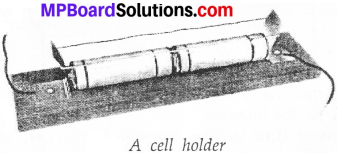
Answer:
It is important to put the cells in right series. The positive terminal of the cell should be connected with negative terminal of the second cell. The switch should be closed properly and bulb should not be fused. If Zubeda will check these then the bulb will certainly glow. Also, in the circuit, there is no any bulb and switch, the connecting wires are not connected with bulb and switch.
Question 13.
In the circuit shown in Fig?
Answer:
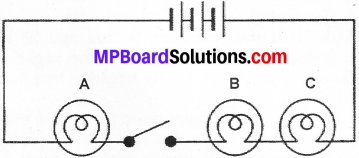
- Would any of the bulb glow when the switch is in the ‘OFF’ position?
- What will be the order in which the bulbs A, B and C will glow when the switch is moved to the ‘ON’ position?
Answer:
- No, bulb will glow.
- The bulb A will glow first, follow by bulb B and then bulb C, because bulb A comes first in the path of electric current flowing from positive terminal towards the negative terminal of the battery.
Extended Learning – Activities and Projects
Question 1.
Set up the circuit shown in Fig. again. Move the key to ‘ON’ position and watch carefully in which direction the compass needle gets deflected. Switch ‘OFF’ the current. Now keeping rest of the circuit intact, reverse the connections at the terminal of the cell. Again switch ‘on’ the current. Note the direction in which the needle gets deflected. Think of an explanation?
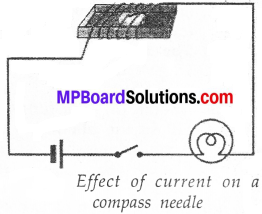
Answer:
When the connection of cell is reversed, the compass needle moves in opposite direction. This shows that the polarity of the magnet depends on the direction of current.
Question 2.
Make four electro – magnets with 20, 40, 60 and 80 turns. Connect them one by one to a battery of 2 cells. Bring the electromagnet near a box of pins. Count the number of pins attracted by it. Compare the strengths of the electromagnets?
Answer:
The strength increases with number of turns in the coil.
Question 3.
Using an electromagnet, you can make a working model of a railway signal as shown in Fig?
Answer:
Do with the help of your subject teacher.
Question 4.
Visit an electric shop. Request a mechanic to show you the various types of fuses and MCB and to explain how they work?
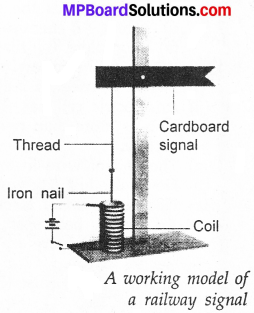
Answer:
Go and visit the nearby shop with your friends.
Electric Current and its Effects Additional Important Questions
Objective Type Questions
Question 1.
Choose the correct alternative:
Question (a)
The electric circuit which is broken at some point is called?
(a) closed
(b) open
(c) short
(d) None of these.
Answer:
(b) open
Question (b)
The amount of heat produced in a wire depends on its?
(a) material
(b) length
(c) thickness
(d) all of these.
Answer:
(d) all of these.
![]()
Question (c)
The direction of flow of conventional current is taken as
(a) -ve to +ve
(b) +ve to -ve
(c) both of these
(d) None of these.
Answer:
(b) +ve to -ve
Question 2.
Fill in the blanks:
- A continuous flow of electric charge is called ………………………….
- In a dry cell energy is converted into ……………………… energy.
- A combination of two or more cells is called a ………………………
- The positive terminal of one cell is connected to the ……………………. terminal of the next cell.
- When the switch of a circuit is in the OFF position, the circuit is ………………………..
- In the bulb, thin wire is called …………………………….
- Current flowing in our household appliances is ………………………….
- A ………………………. is a safety device which prevents damages to electrical circuits and possible fires.
- The switches which automatically turn off when current in a circuit exceeds the safe limit are called ……………………….
Answer:
- Current
- Chemical, electrical
- Battery
- Negative
- Incomplete
- Filament
- A.C.
- Fuse
- MCB
![]()
Question 3.
Which of the following statements are true (T) or false(F):
- Switch is used to regulate the current.
- An electric cell has three terminals.
- Two or more than two cells are interconnected to make a battery.
- The coil of wire in a electric iron is called an element.
- Never use just any wire or strip of metal in place of a fuse.
- Heating effect of electric current is used in a heater.
- An electric bell is an application of an electromagnet.
- A cell or a battery are the sources of electric current in an electric circuit.
Answer:
- True
- False
- True
- True
- True
- True
- True
- True.
Electric Current and its Effects Very Short Answer Type Questions
Question 1.
What is meant by electric current?
Answer:
The flow of negative charges i.e., electrons is called electric current.
Question 2.
Name the various sources of electric current?
Answer:
Cells and storage batteries.
Question 3.
What do you mean by electrically neutral substances?
Answer:
Those substances which have an equal quantity of positive and negative charge.
![]()
Question 4.
What are the two kinds of electric charges?
Answer:
The two kinds of electric charges are positive and negative.
Question 5.
Which terminal of a cell is represented by longer line?
Answer:
Positive.
Question 6.
Where should be the key placed in a circuit?
Answer:
The key or switch can be placed anywhere in the circuit.
Question 7.
What is an open electric circuit?
Answer:
An electric circuit having the switch in off position is called open electric circuit.
Question 8.
What is a closed electric circuit?
Answer:
An electric circuit having the switch in on position is called a closed circuit or a complete circuit.
Question 9.
What is the significance of using symbols in an electric circuit?
Answer:
Using symbols is significant as if we have to show the various batteries, bulbs and switches as they actually look, it would be very cumber some and take a lot of time.
Question 10.
What is a filament?
Answer:
In the bulb there is a thin wire, called the filament, which glows when an electric current passes through it.
![]()
Question 11.
What is the full form of CFL?
Answer:
Compact Fluoroscent Lamp.
Question 12.
What is the full form of MCB?
Answer:
Miniature Circuit Breaker.
Question 13.
What are different hazards of electricity?
Answer:
- ‘Electric shock’
- Tire due to short circuiting’.
Question 14.
List the appliances around you that depend on electricity for their operation. List the appliances that do not use electrical energy?
Answer:
Appliances that depend on electricity : Electric iron, Television, Geysers, Kitchen blender. Appliances that do not use electricity: Solar cells, Sewing Machine, Vehicles.
Question 15.
What energy is converted to electrical energy in a cell?
Answer:
Chemical energy is converted to electrical energy.
Question 16.
Name the three components of the cable used in a house circuit?
Answer:
The cable used in a house circuit has three cores of different colours. The red wire is the live wire. The black is the neutral wire and the green is the earth wire.
Question 17.
What kind of energy transformation takes place in an electric heater?
Answer:
In electric heater, electric energy is converted into heat energy.
Question 18.
Why is alternating current of same voltage more dangerous than direct current?
Answer:
The alternating current of same voltage is more dangerous than direct current because the direction and magnitude of AC changes alternatively and it may produce electric shock.
Question 19.
What happens when fuse melts away?
Answer:
When fuse melts away, the circuit is broken and the flow of current stops.
![]()
Question 20.
What is the main purpose of earthing an electrical appliance?
Answer:
To prevent electric shock.
Question 21.
Why is mica used in elements of an Electric iron?
Answer:
Mica is a insulator.
Question 22.
List the appliances in your house that do not have ground wires?
Answer:
Electric grinder, electric heater, electric oven, electric toaster.
Question 23.
Who discovered magnetic effect of electric current?
Answer:
Hans Christian Oersted.
Question 24.
What are the various effects shown by electricity?
Answer:
- Heating Effect
- Chemical Effect
- Magnetic Effect.
Question 25.
What is electrolysis?
Answer:
The phenomenon of breaking up of a chemical compound under the action of electric current is called electrolysis.
![]()
Question 26.
What causes heating effect in electric appliances?
Answer:
Heating effect is produced by heating element i.e., mainly ‘Nichrome’ which is an alloy of nickel and chromium.
Question 27.
Why is ‘Nichrome’ most commonly used as heating element?
Answer:
Since ‘Nichrome’ has a very high melting point, it does not melt with the flow of current.
Question 28.
Name few processes which are based on chemical effect of electricity?
Answer:
Electroplating, Refining of metals and electrolysis of water.
Question 29.
What is meant by magnetic effect of current?
Answer:
A current carrying wire behaves like a magnet.
![]()
Electric Current and its Effects Short Answer Type Questions
Question 1.
Can electrically neutral substances be made to acquire charge?
Answer:
Yes, the delicate balance between the charges can be disturbed. Thus electrically neutral substances can be made to acquire charge. For example, if we rub a glass rod with silk we brush off some negative charges from the rod. The rod now acquires a net positive charge because it has more positive charges than negative.
Question 2.
What happens when a charged electroscope is connected into a uncharged electroscope by a wire? What is that called?
Answer:
When a charged electroscope is joined to a uncharged electroscope by a wire, charges flow from the charged to the uncharged electroscope through the wire till they are equalised. This flow of charges form an Electric Current.
Question 3.
What are the differences between a simple cell and a storage cell?
Answer:
A simple cell:
- Once the chemicals are used up the cell stope supplying current.
- A small amount of current can be drawn.
A storage cell:
- The used up chemicals can be restored to their original state by reversing the reaction.
- A large current can be drawn.
![]()
Question 4.
What should be the characteristics of an ideal heating element and that of an ideal safety fuse?
Answer:
- Firstly the heating element should have a very high melting point.
- Secondly, it should be a conductor.
- Thirdly it should have high resistance.
- The ideal safety fuse should be firstly it should have low melting point.
- Secondly, it should be a conductor.
- Thirdly, it have low resistance.
Question 5.
Make a list of materials around you which conduct electricity and a list of those that do not.
Answer:
Conductors of electricity are:
All metals, acid, base and salt solutions, aluminium, iron, copper, nickel. Do not conduct electricity are: Paper, rubber, wood, nylon, polythene, bakelite.
Question 6.
What is the significance of the earth wire?
Answer:
The metallic body of an electric appliance is connected to the earth through this earth wire. Sometimes due to faulty wire, the insulation breaks and the live w;re comes into contact with the body of appliance. If the appliance is earthed the charge will quickly flow to the earth, thus protecting us from electric shock.
Question 7.
How does fuse act as a safety device?
Answer:
A fuse is a porcelain holder having a short and thin piece of wire in it called fuse wire which easily melts on heating. Sometimes the insulation of a wire is broken i.e., live wire touches the neutral wire there is a short circuit. When there is a short circuit the fuse wire melts due to heating produced by the high current. The circuit is then broken and the current stops flowing. So damages are prevented.
![]()
Question 8.
On which effect of current does the fuse wire in electric circuits depend? Write two characteristics of a good quality fuse wire?
Answer:
Whenever a current passes through a material, a part or whole of its energy is converted into heat. The part which heats up is called heating elements. An alloy of nickel and chromium called Nichrome is one of the most heating elements.
Two characteristics of a good quality fuse wire are as follows:
- It should have low melting point.
- Is should have high specific resistance.
Question 9.
Write four safety measures to be taken while working with live electric lines?
Answer:
- Do not touch the switch in the main switch board.
- Do not cut the cable of an appliance with a pair of scissors when the appliance is switched on.
- Do not touch any electric poles in the street, especially during the rainy season.
- Do not touch any appliance (when it is switched on) with naked hands. Use rubber gloves..
Question 10.
Draw a battery of four cells?

Question 11.
How does electromagnetic induction find its use or application in generating electricity?
Answer:
The act of moving a magnet quickly in or cut of a coil of wire, can cause a current to flow in the wire. This phenomenon is called electromagnetic induction. This finds its application in generators where the coil is connected to a turbine. That rotates by the energy of falling water and moves the coil and causes current to flow, generators used in power stations have coil kept stationary and the magnet itself is rotated.
Question 12.
What forms the basic principle in electromagnets?
Answer:
Producing electromagnets is based on the principle that when current is passed through a coil it behaves like a magnet i.e., achieves north and south pole. Also if we reverse the direction of current in the coil the two poles exchange places. In electromagnets we insert a piece of iron in such a coil, its domain will get aligned in a direction normal to the face of the coil and the piece of iron gets strongly magnatised and act as electromagnets.
Electric Current and its Effects Long Answer Type Questions
Question 1.
Find the various ways in which two batteries and two bulbs can be connected in a working circuit?
Answer:
Two batteries and two bulbs can be connected in working circuit in two ways:
1. In series as shown in figure.
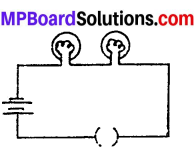
2. In parallel as shown in figure.
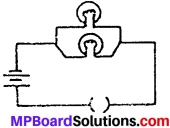
Question 2.
Give the symbols used for: open key; closed key, dry cell, a wire point, a battery and a bulb?
Answer:
The symbols are:
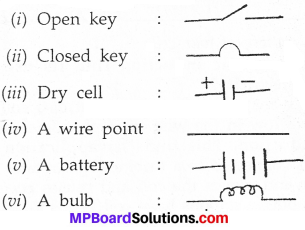
Question 3.
How can conductivity of a substance be tested?
Answer:
We can perform an experiment to test whether the given material conducts electricity or not. Make a circuit with wire, battery, bulb and connect them. If the bulb lights up, we can be sure that current is flowing in the circuit. Break the circuit. Now Fi8- TestinS whether a maternal close the circuit by inserting conducts electricity. different materials in between as (A) Match Stick (B) Pencil (C) Water (D) Eraser (E) Paper cup. Now see whether the bulb lights up. If it lights up, the material used for insertion in a conductor and if the bulb does not light up, the material is an insulator.
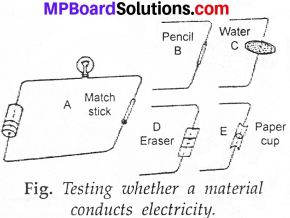
Question 4.
Define Miniature Circuit Breaker (MCB) with diagram?
Answer:
These day Miniature Circuit Breakers (MCBs) are increasingly being used in place of fuses. These are switches which automatically turn off when current in a circuit exceeds the safe limit. You turn them join and the circuit is once again complete. Look for ISI mark on MCBs also.
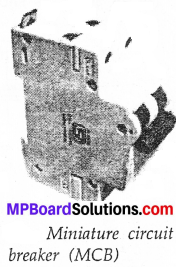
Question 5.
Define the working of an electric bell with circuit?
Answer:
We are quite familiar with an electric bell. It has an electromagnet in it. Fig. shows the circuit of an electric bell. It consists of a coil of wire wound on an iron piece. The coil acts as an electromagnet. An iron strip with a hammer at one end is kept close to the electromagnet.
There is a contact screw near the iron strip. When the iron strip is in contact with the screw, the current flows through the coil which becomes an electromagnet. It, then, pulls the iron strip. In the process, the hammer at the end of the strip strikes the gong of the bell to produce a sound. However, when the electromagnet pulls the iron strip, it also breaks the circuit. The current through the coil stops flowing.
The coil is no longer an electromagnet. It no longer attracts the iron strip. The iron strip comes back to its original position and touches the contact screw again. This completes the circuit. The current flows in the coil and the hammer strikes the gong again. This process is repeated in quick succession. The hammer strikes the gong every time the circuit is completed. This is how the bell rings.
